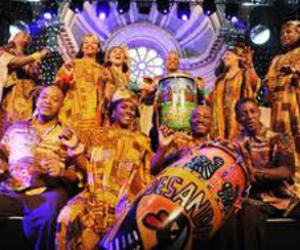Creole Choir of Cuba Brings Island’s Music to Brooklyn
- Submitted by: manso
- Arts and Culture
- 06 / 04 / 2011

By FELICIA R. LEE.June 3, 2011, 2:08 pm. For those who associate modern Cuban music with a Latin jazz sound, here comes the Creole Choir of Cuba to blow away those expectations with their first concert in this country.
The choir, founded in 1994, and which has had extensive, celebrated tours throughout Europe and the Caribbean, lands in Brooklyn to perform Saturday night at the Brooklyn Academy of Music. The choir is composed of Haitian migrants and their descendants, singing mostly in Creole. There are 12 members of the choir; 10 will come to Brooklyn as part of BAM’s ¡Si Cuba! Festival, a feast of Cuban dance, music, visual arts and film that ends June 16.
The choir’s repertory of songs for voices and percussion includes modern Haitian influences as well as 19th-century resistance songs passed down through the group’s ancestors, who landed in Haiti after being captured in West Africa as part of the trans-Atlantic slave trade. Those ancestors were forced to Cuba by their French slave owners after the slave revolts of the 1790s.
Emilia Díaz Chávez, the choir’s director, compares each song to “a small film” that interprets stories of everyday life and survival. Their sound has been compared to Ladysmith Black Mambazo, the South African Gospel group. The choir, which came together in Cuba’s historic colonial town of Camagüey, performs a mix of its own songs and traditional music. They also dip into work beyond their own sphere: the concert at BAM includes African-American spirituals in English, Ms. Chavez said in a recent telephone interview from Havana that was translated from Spanish by a media coordinator from the Brooklyn Academy of Music.
“Our music contains a lot of message about love, about the life of a human being, the situation in Haiti after the earthquake,” said Ms. Chavez, explaining that the choir was in Haiti a month after the earthquake.
“Cuban music has so many different forms,” she continued. “Because of its location in the Caribbean, it has received many different influences from all over the world, and just one of those influences is Haitian. We, as descendants of Haitians, carry the Haitian rhythms that our parents passed on to us, and we continue that tradition. So some of our repertory does not sound Cuban at all, but other songs are traditionally and recognizably Cuban.”
Creole is even Cuba’s second language, after Spanish.
While there has been an increased flow of Cuban arts to this country since the Obama administration eased travel restrictions for cultural groups and artists in 2009, it still took a while for the Creole Choir to get to the United States because of a lack of funds and delays in getting visas, Ms. Chavez said.
The group’s upcoming tour dates can be found online here. So far, the appearance at BAM is their only scheduled performance in this country.
Source: http://artsbeat.blogs.nytimes.com/2011/06/03/creole-choir-of-cuba-brings...
Comments